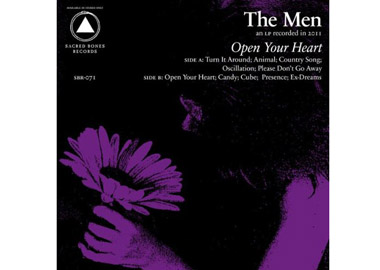The Men
Open Your Heart
(Sacred Bones)
This is their third album in three years, but Open Your Heart demonstrates that instead of running short on ideas, The Men are just hitting their stride. The Brooklyn band have a well deserved reputation for raw rock riffs, blistering velocity and untethered emotional intensity—and there’s plenty of that in evidence. But here there’s more melodicism and bigger hooks throughout—the anthemic “Turn It Around” recalls a punkier and more hyped-up Foo Fighters. They’re also not afraid to get abstract on tunes like “Oscillation” and “Presence,” which use propulsive drones to create a muscular mutant strain of psychedelia. The band also showcase songwriting chops on the raggedly acoustic, country-tinged “Candy.” Even these diversions are thrilling, pacing a record that’s bursting with energy and ideas. It’s one of the best—and smartest—adrenaline shots of the year. —Jeff Jackson
*
HydroElectric
Space Dirt
(Catseyesoup)
Blending ’70s British rock, SoCal desert sludge and synth-powered psychedelia, HydroElectric creates a musical space that’s both laid-back and hard-hitting, layering thick coats of heavy guitar riffage and oozing Moog swirls over solid, mid-tempo grooves. Gradually-building extendo-jams mirror marathon epics by Black Sabbath or Guns ‘n’ Roses, while intermittent organs shift them into Deep Purple/classic Pink Floyd territory. They’re not at all afraid to change keys or time signatures three or four times in a song, but interwoven Chris Cornell-style vocals help to smooth out the odd transitions. Dinosaur Jr. members J Mascis (guitar) and Murph (percussion) make guest appearances on the record, Mascis on the spacey, Bowie-esque “Edge of the World,” (which begins with a J.F.K. sample about the moon landing), and Murph on an inspired cover of the Doctor Who theme. —Tom Sturm
*
volcano!
Pinata
(The Leaf Label Ltd)
Chaos theory, a mathematical concept, shows that even disorder has a beautiful structure. Pinata is in no way chaotic, but it manages to take discordant sounds and weave them into a pleasing tapestry. Authoritative beats and structure underpin a musical style that ebbs and flows, creating structures of sound out of musical elements that dissolve and reform once again in new, surprising ways. “Fighter,” the heart of the album, differs by using lyrics as the driving force of the song. The next two follow a similar pattern, with lyrics rising above the instruments. “Long Gone” brings things full circle; instruments run the show, with lyrics as background. At times the underlying structure of a song is lost, drowned out or put aside. It usually resurfaces, but when it is lost, the music begins to sound more like random noise than coherent dissonance. —Patrick Kelley



